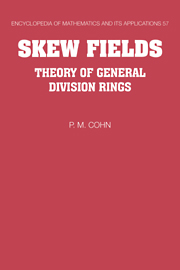Book contents
- Frontmatter
- Contents
- Preface
- Note to the reader
- Prologue
- 1 Rings and their fields of fractions
- 2 Skew polynomial rings and power series rings
- 3 Finite skew field extensions and applications
- 4 Localization
- 5 Coproducts of fields
- 6 General skew fields
- 7 Rational relations and rational identities
- 8 Equations and singularities
- 9 Valuations and orderings on skew fields
- Standard notations
- List of special notations used throughout the text
- Bibliography and author index
- Subject index
6 - General skew fields
Published online by Cambridge University Press: 05 November 2011
- Frontmatter
- Contents
- Preface
- Note to the reader
- Prologue
- 1 Rings and their fields of fractions
- 2 Skew polynomial rings and power series rings
- 3 Finite skew field extensions and applications
- 4 Localization
- 5 Coproducts of fields
- 6 General skew fields
- 7 Rational relations and rational identities
- 8 Equations and singularities
- 9 Valuations and orderings on skew fields
- Standard notations
- List of special notations used throughout the text
- Bibliography and author index
- Subject index
Summary
In any variety of algebras such as groups or rings the members can be defined by presentations in terms of generators and defining relations. Fields do not form a variety, as we saw in 1.2, and they do not have presentations in this sense. In fact the usual mode of construction of commutative fields is quite different: one takes a rational function field over some ground field and then makes an algebraic extension. For skew fields this method works only in very special cases, but there is an analogue of a presentation, in terms of matrices that become singular. Now it is necessary to verify in each case that the outcome is a field and this forms the subject of 6.1. At this stage free fields form a natural topic, but first we need to prepare some tools: In 6.2 we prove the specialization lemma, which generalizes the density principle of the commutative theory: A non-zero polynomial over an infinite (commutative) field assumes non-zero values. The analogue for skew fields states that a non-zero element of a free field (with infinite centre and of infinite degree over it) can be specialized to a non-zero element in the field.
The elements of the free field are described in terms of matrices over the tensor ring and it is therefore of interest to provide a normal form for these matrices. This is done in 6.3 and a corresponding ‘normal form’ for fractions is derived.
- Type
- Chapter
- Information
- Skew FieldsTheory of General Division Rings, pp. 278 - 330Publisher: Cambridge University PressPrint publication year: 1995

